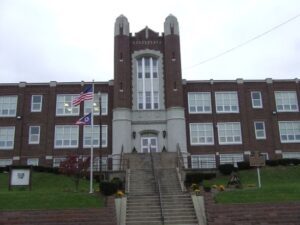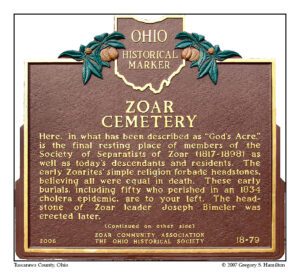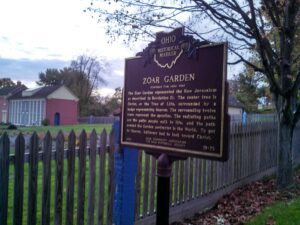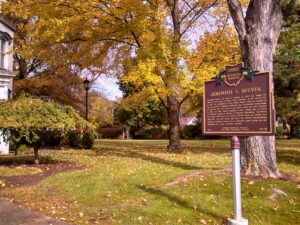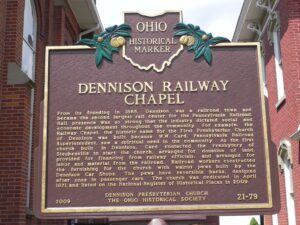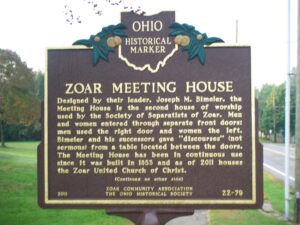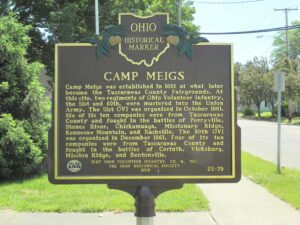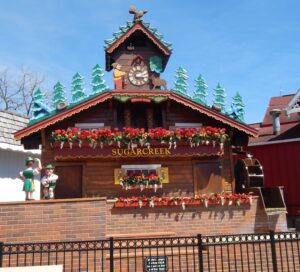, OH
An October 23, 1927, ceremony was held for the laying of the cornerstone for the Dennison High School Building. It opened in the fall of 1928 and was called “Angel’s Castle” in honor of school superintendent William Hiram Angel. The building was designed by J.K. Griffin, an architect from Canton, Ohio, in a style that has the elements of Collegiate Gothic that was popular for school and college buildings during the early twentieth century. The distinguishing architectural features of the entrance towers enhance the school’s prominent location above the street level. Dennison High School is an important visual landmark in the community, as its towers are visible from the downtown area and surrounding neighborhoods. It has retained its integrity of location, materials, design, and association and conveys the early twentieth century ideals of education that the original design of the building was intended to inspire. (Continued on other side)
, OH
Here, in what has been described as “God’s Acre,” is the final resting place of members of the Society of Separatists of Zoar (1817-1898) as well as today’s descendants and residents. The early Zoarites’ simple religion forbade headstones, believing all were equal in death. These early burials, including fifty who perished in an 1834 cholera epidemic, are to your left. The headstone of Zoar leader Joseph Bimeler was erected later. (continued on other side)
, OH
The Zoar Garden was the Separatist’s most public manifestation of their faith, its religious symbolism masked by its lush beauty. It provided both residents and visitors with a place to relax and reflect. This “lustgarden,” or pleasure garden and the accompanying greenhouse were mentioned by travelers as early as 1829. Although some vegetables and fruits were grown here, the garden was filled mainly with flowers. [continued on other side]
, OH
Jeremiah Reeves was born in England in 1845 and began his career in the mills of Wales, United Kingdom, at the age of ten. In 1867, he immigrated to the United States where he worked in the steel mills of Cleveland, Pittsburgh, and Connellsville, Pennsylvania. He met his wife Jane Rees in the latter place and they married in 1869. In 1883, Reeves acquired a steel rolling mill in Dover for $14,000. Despite a history of financial difficulties, the Reeves Iron Works would go on to expand several times and employ over 800 men. The iron works and later the Reeves Manufacturing Company established Dover as an industrial center during the late nineteenth and early twentieth centuries.
, OH
From its founding in 1865, Dennison was a railroad town and became the second largest rail center for the Pennsylvania Railroad. Rail presence was so strong that the industry dictated social and economic development throughout the community. For example, the Railway Chapel, the historic name for the First Presbyterian Church of Dennison was built because W.W. Card, Pennsylvania Railroad Superintendent, saw a spiritual need in the community. As the first church built in Dennison, Card contacted the Presbytery of Steubenville to start the church, arranged for donation of land, provided for financing from railway officials, and arranged for labor and material from the railroad. Railroad workers constructed the furnishing for the church with walnut pews built by the Dennison Car Shops. The pews have reversible backs, designed after ones in passenger cars. The church was dedicated in April 1871 and listed on the National Register of Historical Places in 2009.
, OH
Designed by their leader, Joseph M. Bimeler, the Meeting House is the second house of worship used by the Society of Separatists of Zoar. Men and women entered through separate front doors: men used the right door and women the left. Bimeler and his successors gave “discourses” (not sermons) from a table located between the doors. The Meeting House has been in continuous use since it was built in 1853 and as of 2011 houses the Zoar United Church of Christ.
, OH
Camp Meigs was established in 1861 at what later became the Tuscarawas County Fairgrounds. At this site, two regiments of Ohio Volunteer Infantry, the 51st and 80th, were mustered into the Union Army. The 51st OVI was organized in October 1861. Six of its ten companies were from Tuscarawas County and fought in the battles of Perryville, Stones River, Chickamuaga, Missionary Ridge, Kennesaw Mountain, and Nashville. The 80th OVI was organized in December 1861. Four of its ten companies were from Tuscarawas County and fought in the battles of Corinth, Vicksburg, Mission Ridge, and Bentonville.
, OH
The Alpine Alpa restaurant in Wilmot, Ohio commissioned clockmaker Karl Schleutermann to build the world’s largest cuckoo clock in 1963. Twelve years and $50,000 later, the enormous outdoor clock was finished. It was featured on the cover of the “Guinness Book of World Records” in 1978. After exposure to Ohio’s weather for 30 years, Hampton Hotel’s “Save-A-Landmark” program helped to restore the cuckoo clock to operating condition in 2007. The restaurant closed two years later, and the owner of the local store Walnut Creek Cheese purchased the clock and donated it to the Village of Sugarcreek. The clock was moved to its new home in May 2012. Village leaders and community members returned the clock to working condition and placed it on display for all to enjoy.


